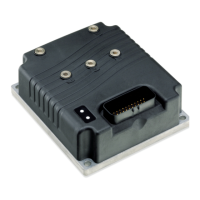Curtis 1222 Manual, os 15
79
2 9 J A N U A R Y 2 0 1 3 D R A F T
must be set before the Left and Right angle parameters are set, because
the center angle is based on the raw reading and normalizes the angle
for setting up the Left and Right angles.
2. Move the Sin/Cos Sensor to the Left position (not to the actual
physical stop, but a small amount away, to allow for sensor tolerance
variation) and observe the angle shown in the Monitor
» Command
Input
» Analog Input » Angle variable. If the observed angle was nega-
tive, set the
Left Angle parameter to the observed angle.
If the observed angle was positive, change the parameter
Swap
Direction. Verify that the steer direction sign is correct (-), and then
return to step b to reset the
Center Angle parameter. Finally, set the Left
Angle parameter to the observed angle.
3. Move the Sin/Cos Sensor to the Right position (not to the actual
physical stop, but a small amount away, to allow for sensor tolerance
variation) and observe the angle shown in the
Angle variable. Set the
Right Angle parameter to the observed angle.
d. For Relative Position Mode (Absolute Mode = Off ):
1. Set the
Center Angle to zero, as this parameter is not used in relative
position mode.
2. Set the
Left Angle parameter to the number of turns (in negative degrees)
required to produce a steer command from center to full left.
3. Set the
Right Angle parameter to the number of turns (in degrees) re-
quired to produce a steer command from center to full right.
e. Set the two fault parameters (
Fault Min and Fault Max) to voltages that will
not be reached during normal operation, but will be reached when the steer
command inputs become faulty (e.g., should there be an open or short cir
-
cuit).
The Fault Min settings must be below the minimum voltage seen on
Analog1 or Analog3 when steered to the maximum left and right positions.
The Fault Max settings must be above the maximum voltage seen on
Analog1 or Analog3 when steered to the maximum left and right positions.
f. The
Tolerance parameter can be set in either of two ways.
1. Obtain the tolerance of Min Volts and Max Volts from the manufacturer’s
specs, and then calculate the worst case difference in voltage between
the calculated voltages and the measured
Analog1 and Analog3 voltages
over the range of the sensor. Set the
Tolerance to a comfortable margin
above the maximum calculated difference.
2. Manually lower the
Tolerance value while adjusting the Sin/Cos Sen-
sor over the entire output range until the fault Sin/Cos Command
Sensor (Fault Code 47) is generated. Repeat this until you find the
minimum Tolerance value that will not cause the fault (over the entire
sensor range). Set the
Tolerance to a comfortable margin above the
minimum tolerance found.
5 — COMMISSIONING

